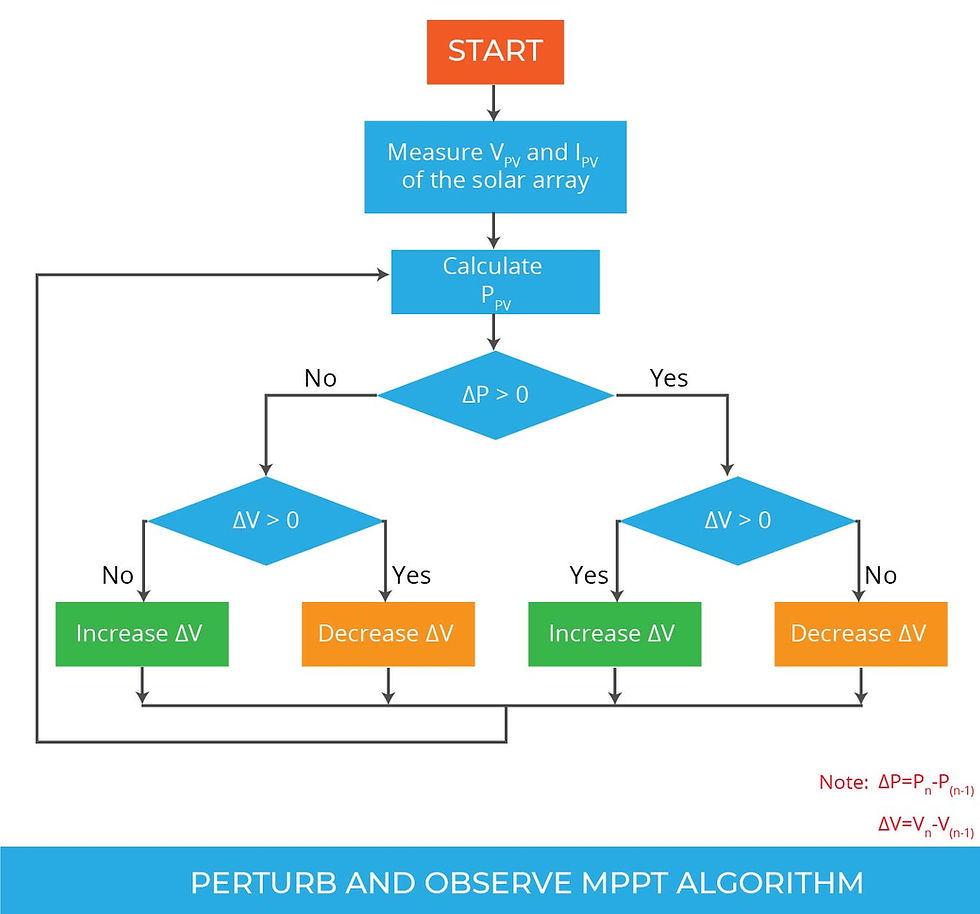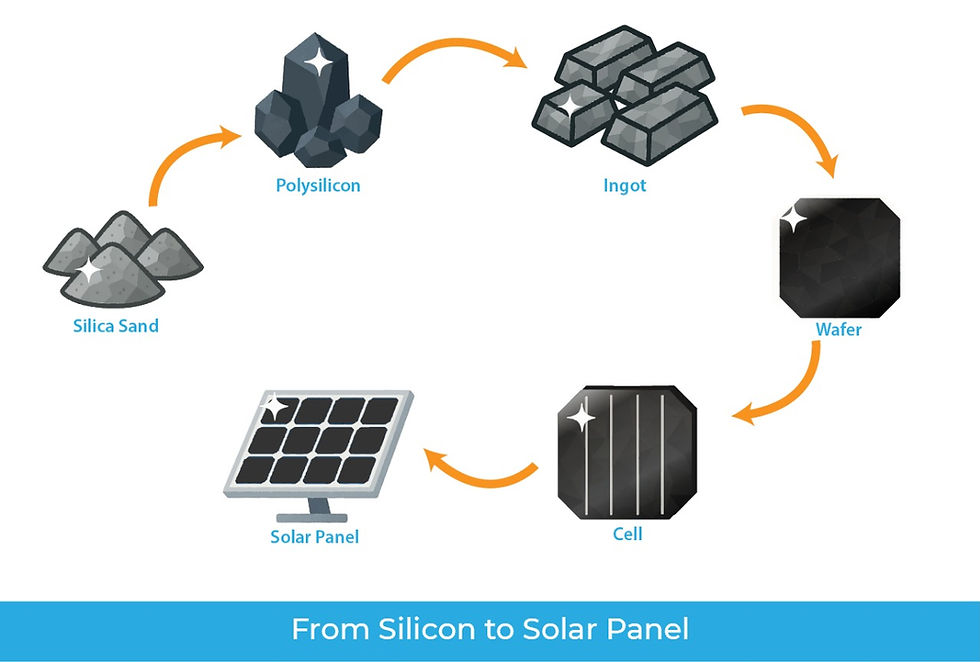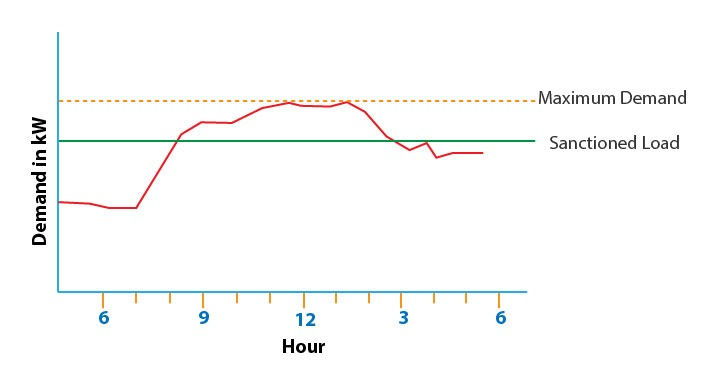Understanding MPPT in Solar Inverters
- Hyde Source

- Jul 28
- 5 min read
What is Maximum Power Point Tracking (MPPT)?
Solar panels do not produce a constant voltage or current. Their power output varies continuously based on environmental factors like sunlight intensity (irradiance), temperature, and even shading. For any given set of conditions, a solar panel has a unique operating point (a specific combination of voltage and current) where it produces its maximum possible power. This point is known as the Maximum Power Point (MPP).

MPPT is an algorithm or technique used by solar inverters to continuously find and operate the solar array at this MPP by, adjusting the electrical load they "see" to ensure they are always operating at their peak efficiency, regardless of the dynamic conditions.
How Does MPPT Work in Solar Inverters?
An MPPT unit is essentially a DC-to-DC converter controlled by a microprocessor. This microprocessor runs an MPPT algorithm that continuously monitors the voltage and current output of the solar panels.
Here's a simplified step-by-step process:

Monitor: The MPPT continuously measures the output voltage (VPV) and current (IPV) from the solar array.
Calculate Power: It calculates the instantaneous power output (PPV=VPV×IPV).
Perturb: The algorithm then makes a small change (perturbation) to the operating voltage of the solar array.
Observe: It observes the effect of this change on the power output.
Adjust:
If the power increases, the algorithm knows it moved in the right direction and continues to adjust the voltage in that same direction.
If the power decreases, it knows it moved past the MPP or in the wrong direction, so it reverses the direction of the voltage adjustment.
Repeat: This process is repeated many times per second, allowing the inverter to "track" the MPP as it shifts due to changing conditions.
By constantly adjusting the voltage and current to find the maximum power point, the MPPT ensures that the solar panels are always delivering the highest possible power output to the inverter for conversion.
Why is MPPT Important for On-Grid Inverter Systems?
MPPT is absolutely critical for optimizing the energy harvest and overall economic viability of on-grid solar systems (grid-tied systems). Here's why:
Maximizing Energy Harvest: The primary reason is to extract the maximum possible energy from the solar panels at all times. Without MPPT, panels would operate at a fixed voltage that might only be optimal under specific conditions, leading to significant power losses as conditions change throughout the day or year.
Adapting to Varying Conditions: On-grid systems are exposed to the full range of environmental fluctuations (sunlight intensity, temperature, partial shading). MPPT ensures that the system dynamically adapts to these changes, maintaining high efficiency even in less-than-ideal conditions (e.g., cloudy days, early mornings/late afternoons, hot afternoons).
Increased System Efficiency and Yield: By continuously operating the panels at their MPP, MPPT can increase the overall energy yield of a solar system by 10% to 30% compared to systems without MPPT (like simpler PWM charge controllers used in some off-grid setups). This directly translates to more electricity generated and greater savings on electricity bills.
Handling Partial Shading (Multi-MPPT Inverters): In residential and commercial on-grid systems, partial shading from chimneys, trees, adjacent buildings, or even dirt/debris is common.
A single MPPT inverter tracks one MPP for an entire string of panels. If one panel in that string is shaded, the entire string's output is limited to the lowest-performing panel.
Multi-MPPT inverters (which are common in modern on-grid systems) have multiple independent MPPT trackers. Each MPPT input can optimize the power for a separate string of panels. This is hugely beneficial for systems with different orientations, tilts, or varying shading patterns across different sections of the array, significantly mitigating the impact of partial shading and maximizing overall system output.
Faster Return on Investment (ROI): The increased energy generation directly leads to faster payback periods for the initial investment in the solar system.
Common MPPT Algorithms Used in Inverters
The "brain" of the MPPT is the algorithm that determines how the voltage is adjusted to find the MPP. Some common algorithms include:
Perturb and Observe (P&O):
This is the most widely used and simplest algorithm. It slightly perturbs (increases or decreases) the operating voltage and then observes the change in power.
If power increases, it continues in that direction;
if it decreases, it reverses.
Incremental Conductance (IncCond):
This algorithm measures incremental changes in current and voltage (dI/dV) and compares them to the instantaneous conductance (I/V). The MPP is reached when dI/dV=−I/V.
Fractional Open-Circuit Voltage (FOCV) / Fractional Short-Circuit Current (FSCC):
These methods are simpler. They are based on the empirical observation that the MPP voltage (VMPP) is approximately a fixed fraction (e.g., 0.7 to 0.8) of the open-circuit voltage (VOC), and similarly for current. The inverter periodically measures VOC (by briefly disconnecting the array) or ISC (by briefly shorting the array) and then sets the operating point based on this fraction.
Advanced / Intelligent Algorithms (e.g., Fuzzy Logic, Neural Networks, Particle Swarm Optimization):
These are more sophisticated algorithms that use artificial intelligence or heuristic methods to predict and track the MPP. They can be very effective in complex scenarios like partial shading with multiple local peaks on the P-V curve.
How Environmental Factors Impact MPPT Operation and Performance
MPPT's core function is to counteract the negative impacts of environmental factors on solar panel output.
Solar Irradiance (Sunlight Intensity):
Impact: Higher irradiance shifts the MPP to a higher current (and slightly higher voltage), leading to increased power. Lower irradiance shifts the MPP to a lower current and slightly lower voltage.
MPPT's Role: MPPT continuously tracks these shifts, ensuring that even on cloudy days or during periods of fluctuating sunlight, the maximum available power is extracted.
Temperature:
Impact: As temperature increases, the voltage of solar panels (VMPP and VOC) decreases significantly, while the current (IMPP) increases slightly. This leads to an overall decrease in power output. Conversely, colder temperatures increase voltage and power.
MPPT's Role: MPPT algorithms are crucial for optimizing performance in varying temperatures. They adjust the operating voltage to capture maximum power, especially in hot conditions where voltage tends to drop, ensuring efficiency is maintained despite the temperature-induced drop.
Partial Shading:
Impact: Partial shading is one of the most challenging conditions. When even a small part of a panel (or a few panels in a string) is shaded, it drastically reduces the current output of those cells. This creates multiple local maximum power points on the array's P-V curve, making it difficult for basic MPPT algorithms to find the true global maximum power point.
MPPT's Role: Multi-MPPT inverters and advanced MPPT algorithms are designed to handle partial shading much more effectively. By having independent trackers for different strings, or by employing sophisticated search algorithms (e.g., global sweep functions), they can navigate the complex P-V curve to locate and operate at the global MPP, minimizing power losses due to shade.
Panel Aging and Degradation:
Impact: Over time, solar panels degrade due to exposure to elements, thermal cycling, and natural aging processes (like LID or PID). This alters their electrical characteristics and shifts their MPP.
MPPT's Role: MPPT algorithms continuously adapt to these gradual changes, ensuring that even aging panels are always operating at their optimal power point, extending their effective productive life.
In conclusion, MPPT is an indispensable technology in modern on-grid solar inverters. It acts as the intelligent bridge between the dynamic nature of solar panel output and the stable requirements of the electrical grid, ensuring that every ray of sunlight is converted into the maximum possible usable electricity.




